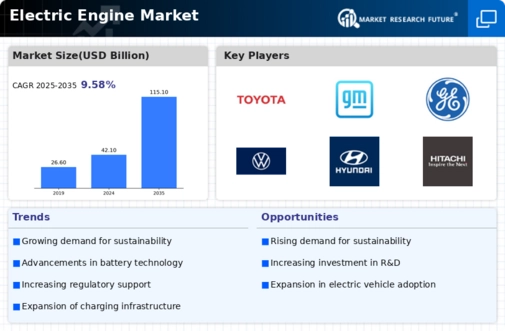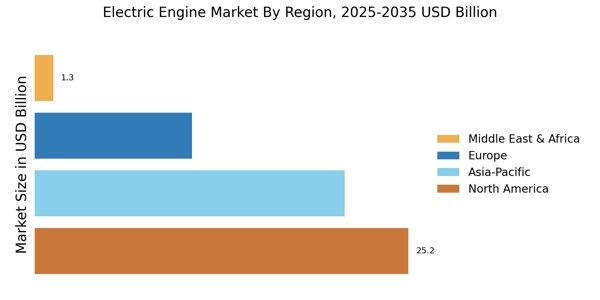The Electric Engine Market is currently characterized by a dynamic competitive landscape, driven by rapid technological advancements and a growing emphasis on sustainability. Major players such as Tesla (US), General Motors (US), and Volkswagen (DE) are at the forefront, each adopting distinct strategies to enhance their market positioning. Tesla (US) continues to lead in innovation, focusing on battery technology and autonomous driving capabilities, while General Motors (US) is heavily investing in electric vehicle (EV) infrastructure and partnerships to bolster its market presence. Volkswagen (DE), on the other hand, is pursuing a strategy of regional expansion, particularly in Asia, to tap into emerging markets and diversify its product offerings. Collectively, these strategies contribute to a competitive environment that is increasingly focused on technological differentiation and sustainability.
Key business tactics within the Electric Engine Market include localizing manufacturing and optimizing supply chains to enhance efficiency and reduce costs. The market appears moderately fragmented, with several key players exerting significant influence. This fragmentation allows for a variety of competitive strategies, as companies seek to carve out niches in specific segments of the market. The collective influence of these key players shapes the market dynamics, fostering an environment where innovation and strategic partnerships are paramount.
In August 2025, Tesla (US) announced a groundbreaking partnership with a leading battery manufacturer to develop next-generation battery technology aimed at increasing energy density and reducing charging times. This strategic move is likely to enhance Tesla's competitive edge, as it positions the company to offer superior performance in its electric vehicles, thereby attracting a broader customer base. The implications of this partnership extend beyond immediate product enhancements, potentially setting new industry standards for battery performance.
In September 2025, General Motors (US) unveiled its ambitious plan to establish a network of fast-charging stations across North America, aiming to alleviate range anxiety among consumers. This initiative not only supports the adoption of electric vehicles but also reinforces GM's commitment to sustainability and customer convenience. By investing in infrastructure, GM is likely to strengthen its market position and foster greater consumer trust in its electric offerings.
In July 2025, Volkswagen (DE) launched a new line of electric vehicles specifically designed for the Asian market, reflecting its strategy to localize production and cater to regional preferences. This move is indicative of Volkswagen's recognition of the growing demand for electric vehicles in Asia, and it positions the company to capitalize on this trend. By tailoring its offerings to meet local needs, Volkswagen may enhance its competitive advantage in a rapidly evolving market.
As of October 2025, the Electric Engine Market is witnessing significant trends such as digitalization, sustainability, and the integration of artificial intelligence in vehicle design and manufacturing. Strategic alliances are increasingly shaping the competitive landscape, as companies collaborate to leverage each other's strengths. Looking ahead, competitive differentiation is expected to evolve, with a pronounced shift from price-based competition to a focus on innovation, advanced technology, and supply chain reliability. This transition underscores the importance of adaptability and forward-thinking strategies in maintaining a competitive edge in the electric engine sector.


















Leave a Comment